Forests are often described as the lungs of our planet, producing oxygen and absorbing carbon dioxide, but their importance goes far beyond their role in maintaining Earth’s atmosphere. These lush and diverse ecosystems are home to a staggering array of plant and animal species and provide countless benefits to humans. In this article, we will dive into the secret lives of trees and unveil 20 fascinating facts about forests that highlight their beauty, complexity, and critical role in sustaining life on our planet.
20 Fascinating Facts About Forests
1. Ancient Sentinels of Time
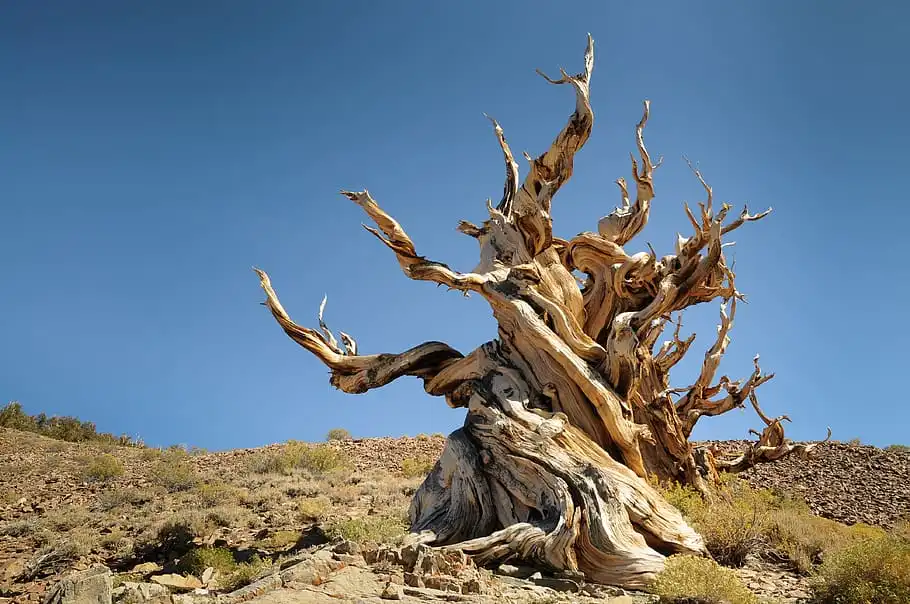
Our journey into the secret lives of trees begins with some of the most ancient and awe-inspiring residents of Earth’s forests.
In the heart of California stands a tree named “Methuselah,” a Great Basin bristlecone pine that’s been around for a staggering 4,855 years.
This makes Methuselah the oldest known living tree on the planet, bearing silent witness to countless generations of humans, changes in climate, and the rise and fall of civilizations.
But Methuselah is not alone in its remarkable longevity. The “Sarv-e Abarqu,” an ancient cypress tree in Iran, has been growing for over 4,000 years.
These trees, like many others hidden within the depths of forests worldwide, offer a glimpse into the enduring resilience of life on Earth.
2. The Hidden Communication Network
Beneath the forest floor lies a hidden world of intricate communication networks that are both fascinating and vital to the survival of these ecosystems.
Trees engage in a complex underground conversation through a vast network of fungal threads called mycorrhizal networks. These mycorrhizal networks connect trees, allowing them to exchange essential nutrients, water, and even chemical signals.
Incredibly, trees can communicate with each other through these networks, sharing information about environmental threats, insect attacks, and resource availability.
In some cases, healthy trees have been known to send nutrients to neighboring trees in distress, acting as a support system within the forest community.
3. Mystical and Enigmatic Forests
Throughout history, forests have been the source of countless myths, legends, and mystical beliefs. These enchanted landscapes have often been depicted as places of magic and mystery, inhabited by mythical creatures and hidden treasures. The ancient Celtic druids revered oak trees as sacred, believing they were gateways to other realms.
In Japan, the Aokigahara Forest at the base of Mount Fuji is known as the “Sea of Trees” and has a haunting reputation as a site for suicides. The dense forest’s eerie silence and otherworldly beauty have contributed to its mystique. Meanwhile, in the Amazon rainforest, indigenous tribes have long considered the towering kapok tree as a connection between the earth and the sky, and a symbol of life itself.
4. The Forest Pharmacy
Forests are not just serene and magical places; they are also storehouses of natural medicine.
Many tree species have been used for centuries in traditional herbal remedies and modern pharmaceuticals.
For instance, the bark of the cinchona tree is the source of quinine, a key ingredient in the treatment of malaria. The Pacific yew tree provided the compound Taxol, crucial in the fight against cancer.
Moreover, simply being in the presence of trees has been shown to have numerous health benefits. Studies suggest that “forest bathing,” or spending time in a forest, can reduce stress, lower blood pressure, and boost the immune system.
It’s no wonder that more and more people are turning to “Shinrin-Yoku” as a form of natural therapy.
5. The Lung Connection
Forests are often described as the “lungs of the Earth” because they play a crucial role in producing oxygen and absorbing carbon dioxide.
What’s truly fascinating is the staggering amount of oxygen produced by forests. In a year, an acre of mature trees can produce enough oxygen to sustain 18 people. Additionally, they are home to more than 80% of the world’s terrestrial biodiversity.
This highlights the critical importance of preserving and protecting our forests in the face of deforestation and climate change.
6. The Secret of “Crown Shyness”
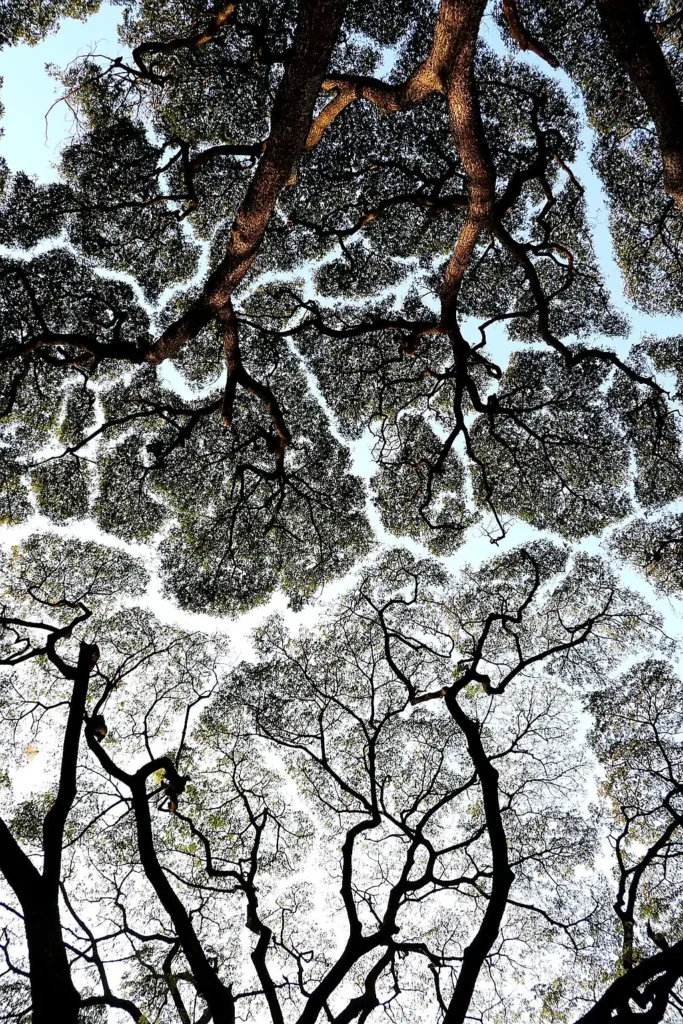
Intriguingly, some tree species exhibit a phenomenon known as “crown shyness.”
In forests where this occurs, the upper branches of neighbouring trees avoid overlapping, leaving narrow gaps or channels between them. This creates a mesmerizing pattern of tree crowns that seem to respect each other’s personal space.
The exact reason for crown shyness remains a subject of scientific investigation, but it is believed to be related to a combination of factors, including competition for sunlight, reduction of fungal and pest transmission, and damage prevention during storms.
7. The World’s Largest Organism
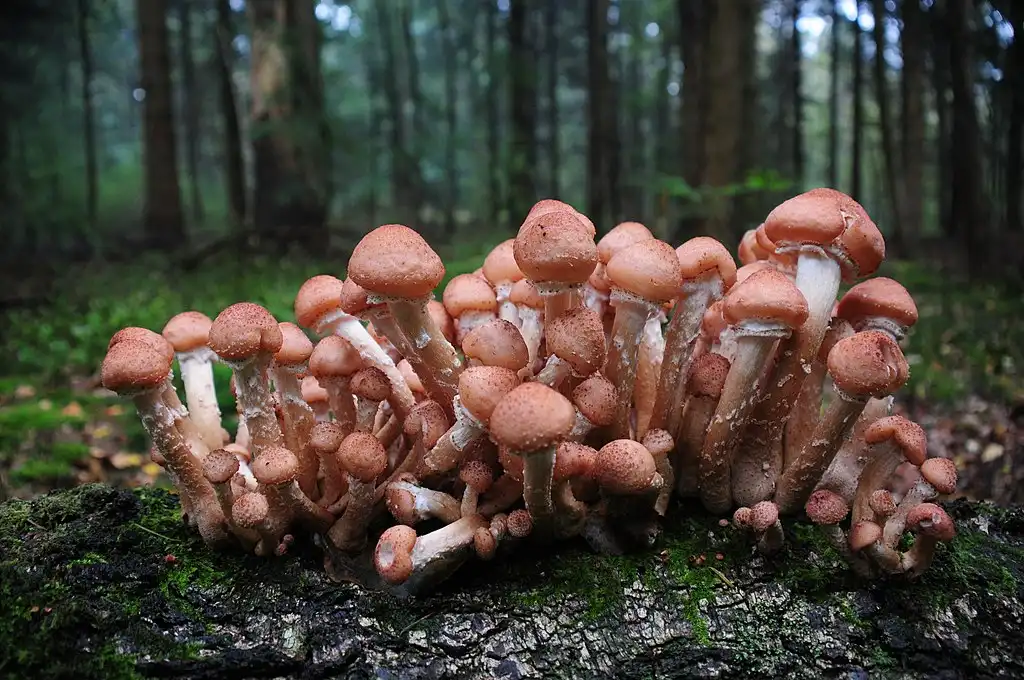
When it comes to the title of the world’s largest organism, you might imagine a massive animal like a blue whale. However, the true champion of size in the biological world is a fungal organism that lives underground in Oregon’s Malheur National Forest.
“Armillaria Ostoyae”, commonly known as the honey fungus, spans over 2,385 acres and is estimated to be thousands of years old. This colossal underground network of fungal threads has earned it the title of the largest organism on Earth.
8. Trees That Don’t Age: Clonal Colonies
Certain trees, such as quaking aspens, employ a unique mode of reproduction, extending beyond traditional seed propagation. These trees produce extensive clonal colonies through the growth of subterranean runners.
Among these extraordinary arboreal phenomena is the Pando grove in Utah, a testament to nature’s endurance. Scientists estimate this grove to be an astonishing 80,000 years old, solidifying its status as one of Earth’s most ancient and enduring life forms.
This remarkable forest, with its interconnected root system, has withstood millennia of environmental changes, exemplifying the extraordinary resilience and longevity that some trees can achieve through their clonal colonies.
9. A Forest in the Desert: The Bosque del Apache
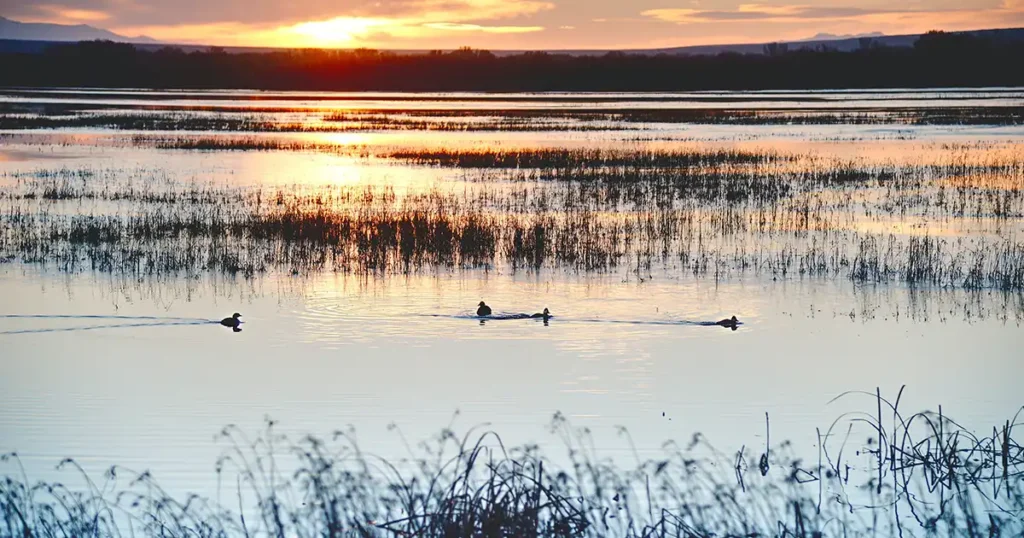
Nestled within the arid expanse of the New Mexican desert, the Bosque del Apache National Wildlife Refuge stands as a remarkable testament to nature’s ability to adapt and endure. Here, a flourishing cottonwood forest thrives, sustained by the life-giving waters of the Rio Grande.
This oasis in the midst of a harsh desert landscape is a poignant reminder of nature’s remarkable resilience. It showcases how, even in the harshest of environments, life can find a way to not only survive but thrive, creating a sanctuary where vibrant ecosystems and diverse wildlife flourish against all odds.
10. The Whistling Thorns of Africa
In the African savannas, acacia trees have evolved an ingenious defense strategy against herbivores. When these browsing animals nibble on their leaves, these trees deploy an unusual and effective survival tactic.
They emit a high-pitched whistle, acting as an alarm signal to neighboring acacias. In response to this distress call, nearby acacias promptly increase the production of defensive compounds like tannins and toxins in their leaves.
This chemical response makes the leaves less palatable and discourages further herbivore browsing. The whistling thorns of Africa not only showcase the intricate ways in which plants can adapt and communicate within their ecosystems but also exemplify the dynamic and interconnected relationships that exist in nature.
11. Tree Rings: Nature’s Historical Record
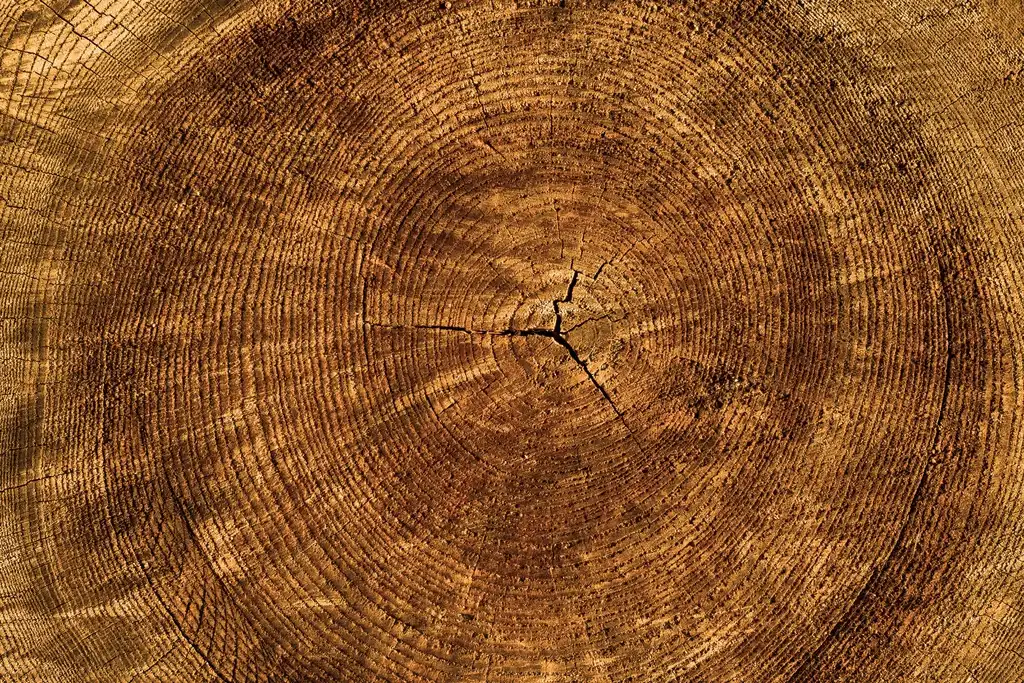
Tree rings, like nature’s historical archives, tell the stories of individual trees in a way that only time can record. Within a tree’s trunk lies a timeline of its existence, marked by concentric rings that offer a window into its past.
Each ring represents a year, and its width reveals the tree’s growth rate during that time. Lush years, marked by wider rings, indicate favorable conditions, while narrow rings may signify periods of stress like drought or disease.
Beyond a tree’s personal history, these rings hold broader environmental clues. Dendrochronologists, the scientists who study tree rings, can reconstruct past climates and ecosystems by examining the patterns of rings across multiple trees.
This intricate science not only unravels the mysteries of individual trees but also helps us better understand the ever-evolving narrative of our planet’s natural history.
12. The Oldest Trees on Continents
Africa’s storied landscape boasts an enduring emblem of resilience and longevity: the ancient baobab trees, affectionately known as the “trees of life.” These arboreal titans defy the passage of centuries, with some venerable specimens boasting lifespans that stretch into thousands of years. Their significance transcends mere botanical marvels, weaving into the very fabric of the continent’s history and ecosystems.
Baobabs stand as natural landmarks, their massive trunks serving as waypoints for generations of travelers navigating the vast African terrain. In regions where water is scarce, these majestic trees store precious reserves within their bulbous trunks, offering a lifeline to both human communities and wildlife during arid spells.
Furthermore, the hollowed interiors of mature baobabs have functioned as sanctuaries and gathering places for people, preserving cultural heritage and fostering a sense of community. Baobabs have sustained life through their nourishing fruits, aptly named “monkey bread,” which provide sustenance for a myriad of creatures, thus contributing to the intricate web of life in Africa’s diverse ecosystems.
In essence, the ancient baobabs are not just trees; they are living witnesses to the ebb and flow of time. They are symbols of tenacity and continuity, entwined with the past, present, and future of Africa. These ageless sentinels encapsulate the awe-inspiring ability of nature to endure and thrive across millennia.
13. The Remarkable Fungus Among Us
In the hidden realms of our forests, an extraordinary phenomenon unfolds—the remarkable alliance between certain fungi and trees. Among these fungal wonders is the bioluminescent Mycena Lux Aeterna, which forges a symbiotic bond with its arboreal counterparts. In this mutualistic relationship, these fungi and trees exchange vital nutrients and resources, strengthening both parties in the process.
However, the enchantment doesn’t end there. As night falls, the forest unveils its mystical side, with Mycena Lux Aeterna casting a soft, otherworldly glow. This bioluminescence transforms the woodland into a magical realm, with the forest floor and tree trunks adorned in an ethereal, luminous display. These radiant fungi not only illuminate the night but also captivate the imagination, conjuring scenes reminiscent of fairy tales and dreams.
Such remarkable collaborations in nature remind us of the hidden wonders that abound in our ecosystems, where even the tiniest organisms can create awe-inspiring beauty in the dark corners of the forest.
14. The Forest’s Symphony: Birdsong
Within the heart of the forest, a captivating symphony unfolds as birds fill the air with their melodious songs. These tuneful serenades serve a multitude of purposes in the avian world, from staking territorial claims to orchestrating courtship rituals.
Each bird species contributes its unique note to this woodland chorus, creating a rich tapestry of sound that resonates through the trees. The diversity of birdlife in forests not only enchants our senses but also plays a vital role in maintaining the ecological balance of these ecosystems.
Some birds act as nature’s gardeners, spreading seeds that promote the growth of new flora. Others help control insect populations, contributing to the health of the forest.
In essence, the symphony of birdsong in forests is a testament to the intricate web of life, where each species plays a part in maintaining the harmony and vibrancy of this natural habitat.
15. The Hidden Forests of the Sea
Kelp forests, concealed beneath the ocean’s surface, are aptly termed “forests of the sea” for their striking resemblance to terrestrial woodlands. These submerged ecosystems serve as vital habitats and sustenance sources for an array of marine creatures, from diminutive fish to charismatic sea otters.
In these underwater realms, towering kelp fronds sway in the currents, forming intricate ecosystems where diverse life flourishes. Just as trees shelter terrestrial animals, kelp provides refuge and nourishment for a vibrant underwater community, illustrating the interconnectedness of life in our planet’s watery depths.
16. The Dancing Trees of the Wind
Amidst the fury of strong winds, trees display a mesmerizing ballet, swaying and dancing in harmony. This elegant response not only captivates observers but also plays a vital role in the trees’ resilience.
As they flex and sway, trees effectively absorb the energy of the wind, mitigating its force and reducing the risk of damage. This dynamic interaction is not merely a spectacle; it’s a survival strategy honed by nature over eons.
Trees that dance in the wind are a testament to their adaptability and ability to weather the elemental forces of the natural world, ensuring their endurance for generations to come.
17. The Tree That Bleeds Red: Dragon’s Blood Tree
In the remote Socotra archipelago of Yemen, an extraordinary tree, known as the dragon’s blood tree, thrives. Its distinctive name arises from the crimson resin it exudes, akin to the mythical blood of dragons.
For centuries, this vivid resin has held a multifaceted role in human culture and practicality. Its striking hue has been harnessed for dyes and artistry, while its unique properties have been valued in traditional medicine.
Moreover, it has played a role in ancient rituals, adding an aura of mystique to this already remarkable tree. The dragon’s blood tree stands as a living testament to the intersection of nature’s wonders and human ingenuity.
18. The Ghosts of the Forest: Albino Redwoods
Within the hushed enclaves of the forest, ghostly figures emerge in the form of albino redwood trees. These rare anomalies defy the norm, devoid of the green chlorophyll needed for photosynthesis.
In an astonishing feat of survival, these pale specters establish a parasitic relationship, anchoring themselves to the roots of neighboring redwoods. Here, they siphon off vital nutrients, relying entirely on their verdant companions for sustenance.
Albino redwoods, with their ghostly appearance and unconventional dependence, stand as true enigmas within the heart of the forest, serving as a testament to nature’s capacity for adaptation and the mysteries that continue to unfold in the wild.
19. Forests and Human Imagination
Forests are timeless crucibles of human imagination, forging mythical landscapes in the tapestry of history. Enchanted woods in folklore, with their lurking spirits and mysterious depths, have ignited tales of wonder and caution.
These sylvan realms have birthed heroes, heroines, and quests in epic proportions, embodying the human quest for understanding the unknown. In the realms of fantasy literature, from Tolkien’s Middle-earth to the enchanted woods of Narnia, forests become living entities, teeming with magic and mystery.
Through the ages, forests have beckoned humanity into their leafy embrace, inspiring endless tales, stirring dreams, and reminding us that within their depths, both beauty and the unknown await.
20. The Serengeti of the North: Białowieża Forest
Nestled on the border of Poland and Belarus, the Białowieża Forest stands as a living testament to Europe’s ancient woodlands. As a UNESCO World Heritage Site, it preserves a fragment of the primeval forest that once blanketed the continent.
This remarkable ecosystem harbors the European bison, a symbol of resilience and survival. These colossal creatures, the heaviest land animals in Europe, roam freely amidst the forest’s dense canopy and tranquil clearings.
Białowieża Forest is not just a sanctuary for biodiversity; it’s a poignant reminder of the value of preserving our natural heritage and the enduring beauty of untouched landscapes in an ever-changing world.
You may also like:
Conclusion
As we conclude our journey into the fascinating facts about forests, it becomes evident that forests are not merely collections of trees but complex, interconnected ecosystems that sustain life on Earth. From their ancient sentinels to their hidden communication networks, from their mystical allure to their medicinal treasures, the world’s forests continue to amaze and inspire us.
It is our responsibility to protect and preserve these invaluable ecosystems, recognizing their vital role in maintaining a healthy planet. By doing so, we ensure that the secrets and wonders of Earth’s forests can be enjoyed by future generations, continuing to captivate and enrich our understanding of the natural world.



